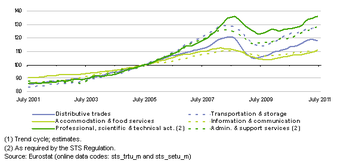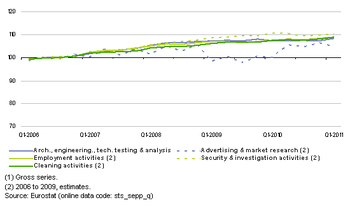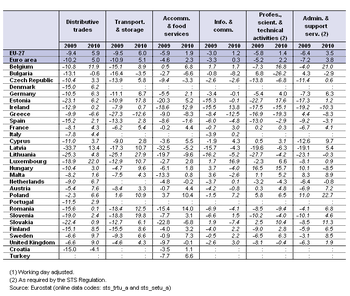Archive:Services statistics - short-term indicators
- Data from September 2011, most recent data: Further Eurostat information, Main tables and Database.
This article examines recent statistics in relation to developments for service activities in the European Union (EU). Short-term business statistics (STS) are provided in the form of indices that allow the rapid assessment of the economic climate within services, providing a first assessment of recent developments for a range of activities. Traditionally, short-term business statistics were concentrated on industrial and construction activities, and to a lesser extent retail trade. Since the middle of the 1990s, major developments in official statistics within the EU have seen short-term data collection efforts focus increasingly on services.
Main statistical findings

(2005=100) - Source: Eurostat (sts_trtu_m) and (sts_setu_m)

(2005=100) - Source: Eurostat (sts_trtu_m)

(2006=100) - Source: Eurostat (sts_sepp_q)

(2006=100) - Source: Eurostat (sts_sepp_q)

(%) - Source: Eurostat (sts_trtu_a) and (sts_setu_a)

(%) - Source: Eurostat (sts_trtu_a)
Services turnover fell by 8.5 % in the EU-27 in 2009 compared with the year before but rebounded in 2010 increasing by 5.0 %. Among service activities (at the NACE Rev. 2 section level), the fastest rates of turnover growth in 2010 were recorded for transportation and storage activities, as well as distributive trades, where turnover grew by around 6 % having fallen by more than 9 % in 2009.
As can be seen from Figure 1, despite strong growth in the EU-27, the level of sales for both activities in June 2011 had not quite returned to the respective peaks that had been recorded prior to the effects of the financial and economic crisis being felt; sales remained 2.1 % lower for distributive trades and 0.7 % lower for transportation and storage.
A similar pattern was observed for accommodation and food services where the June 2011 level of the index for the EU-27 was 1.7 % below its February 2008 peak. In information and communication services the level of sales in June 2011 was also very close to its pre-crisis peak, just 0.3 % lower, while for professional, scientific and technical activities the level of sales was marginally (0.1 %) above its pre-crisis peak. Administrative and support services activities was the only services section where the recent recovery had brought the level of sales clearly back above the pre-crisis peak, as sales in June 2011 stood 1.5 % higher than their February 2008 peak.
While turnover shows sales in current prices, the volume of sales indicates the situation once price changes have been removed. The decline in the volume of sales in retail trade in 2009 reached -1.7 % in the EU-27, but this activity rebounded with growth of 0.7 % in 2010. A monthly series (see Figure 2) shows the volume of retail sales peaked in the EU-27 in January 2008 and fell a total of 2.2 % through to August 2009; positive rates of change returned with an increase of 1.1 % by September 2010, after which there was again a modest decline in the volume of sales. Figure 2 shows that some parts of retail trade were still experiencing a noticeable decline in their respective volume of sales in the first half of 2011, in particular the large activity of retailing of food, beverages and tobacco, as well as the smaller activity of the retail sale of other household equipment in specialised stores.
Among the services for which an EU-27 price index is shown in Figures 3a and 3b two stand out as having atypical developments – telecommunications and sea and coastal water transport. Since 2006 (the beginning of the series) EU-27 output prices for telecommunications have been on a steady downward path and in just over five years they fell by a total of 18.2 %. Output prices for sea and coastal water transport are remarkable for their relatively high volatility, although the net impact of these movements was that prices in the first quarter of 2011 were within 0.3 % of their level at the beginning of the series. Most of the other services recorded overall price increases in a range of 6 % to 12 % during the five years shown, with air transport output prices increasing at a faster pace, rising by an amount close to 15 %.
The developments for services turnover observed for the EU-27 as a whole in 2009 and 2010 were common across many of the individual EU Member States. Every Member State (Italy, not available) recorded a fall in services turnover in 2009 and all except Bulgaria and Greece recorded an increase in 2010, with growth exceeding 10 % in Luxembourg and Belgium. Table 1 provides an analysis of the two latest rates of change for each of the services sections covered by short-term business statistics. Growth rates in excess of 20 % were recorded in 2010 for distributive trades in Luxembourg, for transportation and storage in Lithuania, and for administrative and supporting activities in Belgium and Poland.
The fall in the volume of sales in retail trade in 2009 and it subsequent (partial) rebound in 2010 observed for the EU-27 was not so regularly reproduced across the EU Member States. Indeed, this pattern was only reproduced in five of the Member States, but this group of five included two of the largest ones, namely Italy and Germany – the others were Cyprus, Malta and Finland. The United Kingdom and Poland were among five Member States that recorded an increase in the volume of sales in retail trade in both 2009 and 2010, while France recorded no growth in 2009 and an increase in 2010. Most Member States, 15 in total, recorded a fall in the volume of sales in retail trade in both 2009 and 2010: for Spain and four other countries, the decline in sales in 2010 was the third consecutive year of contraction for this indicator, and for Denmark and Hungary it was the fourth consecutive year. The situation in Belgium was unique insofar as it was opposed to the overall pattern of developments in the EU-27, as the volume of sales in retail trade increased in 2009 and then subsequently fell in 2010.
Data sources and availability
Short-term business statistics (STS) on services are compiled within the same methodological framework as short-term statistics on industry and construction. The article on short-term developments in industry and construction provides information on: the STS Regulation; the different forms of presentation of indices, namely gross, working-day adjusted, seasonally adjusted, and trend; the implementation of NACE Rev. 2; and the exercise to rebase STS indices to a new base year of 2005=100.
The turnover index and the employment index are compiled for retail trade and for other services. For retail trade one additional indicator is provided, namely the volume index of retail sales, which is effectively a deflated turnover index. Furthermore, service output price indices have been developed for a selection of services in recent years.
The index of turnover shows the evolution of sales in value terms. Note that prices for some services have actually been falling, perhaps due to market liberalisation and increased competition (for example, telecommunications and other technology-related activities). In such cases, the rapid growth rates observed for turnover value indices for some activities would be even greater in volume terms.
Retail trade indices have particular importance because of the role of retail trade as an interface between producers and final customers, allowing retail sales turnover and volume of sales indices to be used as short-term indicators for final domestic demand by households. The volume measure of the retail trade turnover index is more commonly referred to as the index of the volume of (retail) sales. To eliminate the price effect on turnover in retail trade, a deflator of sales is used. This deflator is an index with a similar methodology to that of an output price index, but it is adapted specifically for retail trade; it reflects price changes in the goods sold rather than those in the retail sales service provided.
Context
Some of the most important STS indicators are a set of Principal European Economic Indicators (PEEIs) that are essential to the European Central Bank (ECB) for conducting monetary policy within the euro area. Three PEEIs concern services short-term business statistics, namely indices covering: the volume of sales in retail trade, turnover in other services, and output prices of other services.
Further Eurostat information
Publications
Main tables
- Industry, commerce and services (t_sts)
- Trade and services - Services
- Trade and services - Retail
Database
- Trade and services
Dedicated section
Methodology / Metadata
- Methodology of short-term business statistics – interpretation and guidelines
- Methodology of short-term business statistics – associated documents
- Methodological guide for developing producer price indices for services
- STS Metadata in SDMX format
- More information on Metadata in Eurostat